warning light CHEVROLET LOW CAB FORWARD 2018 Manual Online
[x] Cancel search | Manufacturer: CHEVROLET, Model Year: 2018, Model line: LOW CAB FORWARD, Model: CHEVROLET LOW CAB FORWARD 2018Pages: 358, PDF Size: 6.32 MB
Page 249 of 358

Chevrolet Low Cab Forward Owner Manual (GMNA-Localizing-U.S.-
11254764) - 2018 - crc - 12/5/16
248 Vehicle Care
Danger (Continued)
battery. Personal injury
(particularly to eyes) or property
damage may result from battery
explosion, battery fluid or
electrical (short circuit) burns. You
and others could be seriously
injured or killed.
If the negative cable is disconnected
from the negative terminal on the
battery within 3 minutes after turning
the engine control switch to the
"LOCK" position, the engine control
module may malfunction.
Checking the Battery
Your new vehicle is equipped with
DELKOR batteries. They need no
periodic electrolyte level
maintenance. Its top is permanently
sealed (except for two small vent
holes) and has no filler caps. You
will never have to add water.
Remember to check and recharge
the battery as necessary, as well as
keep connection clean. The hydrometer (green-eye test
indicator) in the top of each battery
(if equipped) provides information
for testing purposes only.
If the vehicle is not going to be
driven for 30 days or longer,
disconnect the ground cable from
the negative (–) terminal of the
batteries to prevent discharge.
For full power needs at replacement
time, a battery with the same
specifications, as shown on the
original battery's label, is
recommended.
{Warning
Battery posts, terminals and
related accessories contain lead
and lead compounds, chemicals
known to the State of California to
cause cancer and reproductive
harm. Wash hands after handling.
You and others could be seriously
injured.
Fuel Filter
Change the fuel filter in accordance
with the Maintenance Schedule or
when the fuel filter indicator light
(amber) comes on.
Drain the water when the water
separator (fuel filter) warning light
comes on. (Drain the water from the
chassis-side fuel filter and
engine-side fuel filter.)
Failure to replace the fuel filter when
needed may lead to fuel system
damage. Your authorized dealer can
inspect your fuel filter and replace
your fuel filter, if needed.
Page 256 of 358
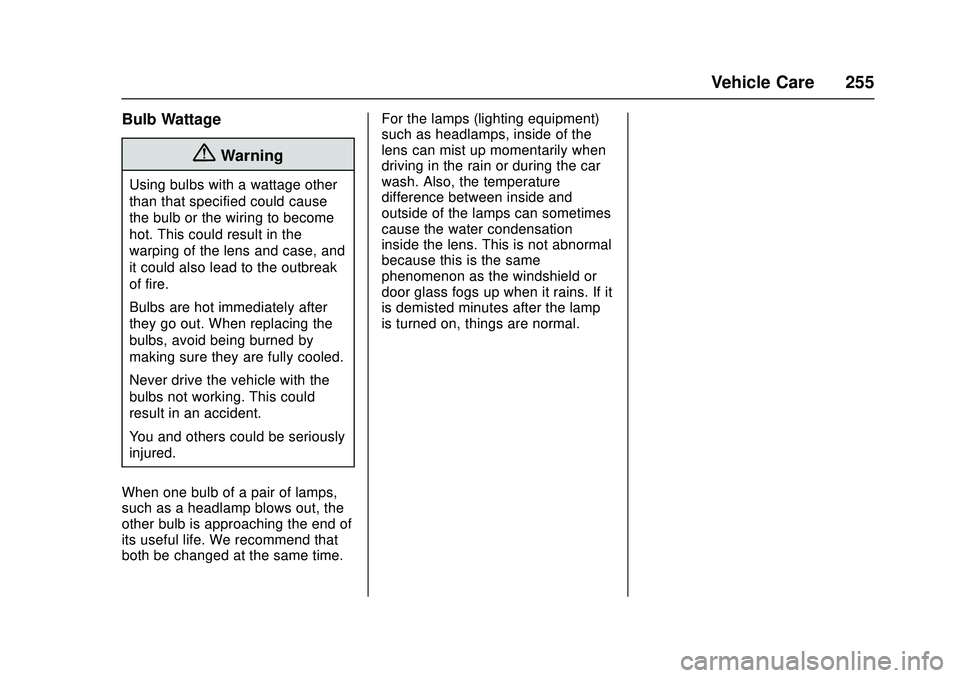
Chevrolet Low Cab Forward Owner Manual (GMNA-Localizing-U.S.-
11254764) - 2018 - crc - 12/5/16
Vehicle Care 255
Bulb Wattage
{Warning
Using bulbs with a wattage other
than that specified could cause
the bulb or the wiring to become
hot. This could result in the
warping of the lens and case, and
it could also lead to the outbreak
of fire.
Bulbs are hot immediately after
they go out. When replacing the
bulbs, avoid being burned by
making sure they are fully cooled.
Never drive the vehicle with the
bulbs not working. This could
result in an accident.
You and others could be seriously
injured.
When one bulb of a pair of lamps,
such as a headlamp blows out, the
other bulb is approaching the end of
its useful life. We recommend that
both be changed at the same time. For the lamps (lighting equipment)
such as headlamps, inside of the
lens can mist up momentarily when
driving in the rain or during the car
wash. Also, the temperature
difference between inside and
outside of the lamps can sometimes
cause the water condensation
inside the lens. This is not abnormal
because this is the same
phenomenon as the windshield or
door glass fogs up when it rains. If it
is demisted minutes after the lamp
is turned on, things are normal.
Page 257 of 358
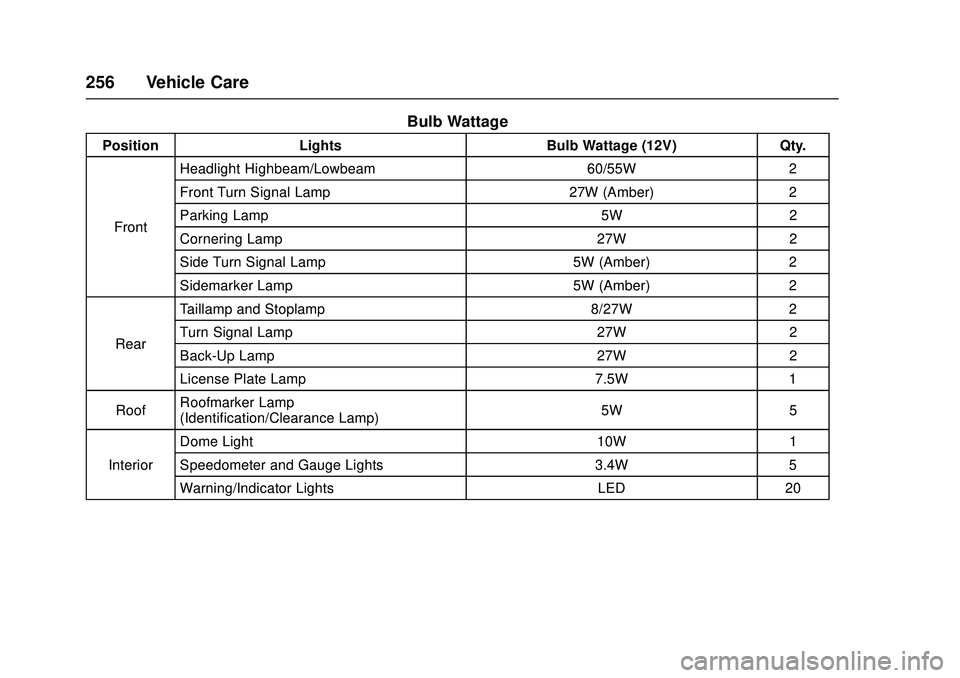
Chevrolet Low Cab Forward Owner Manual (GMNA-Localizing-U.S.-
11254764) - 2018 - crc - 12/5/16
256 Vehicle Care
Bulb Wattage
PositionLights Bulb Wattage (12V)Qty.
Front Headlight Highbeam/Lowbeam
60/55W2
Front Turn Signal Lamp 27W (Amber)2
Parking Lamp 5W2
Cornering Lamp 27W2
Side Turn Signal Lamp 5W (Amber)2
Sidemarker Lamp 5W (Amber)2
Rear Taillamp and Stoplamp
8/27W2
Turn Signal Lamp 27W2
Back-Up Lamp 27W2
License Plate Lamp 7.5W1
Roof Roofmarker Lamp
(Identification/Clearance Lamp) 5W
5
Interior Dome Light
10W1
Speedometer and Gauge Lights 3.4W5
Warning/Indicator Lights LED20
Page 277 of 358
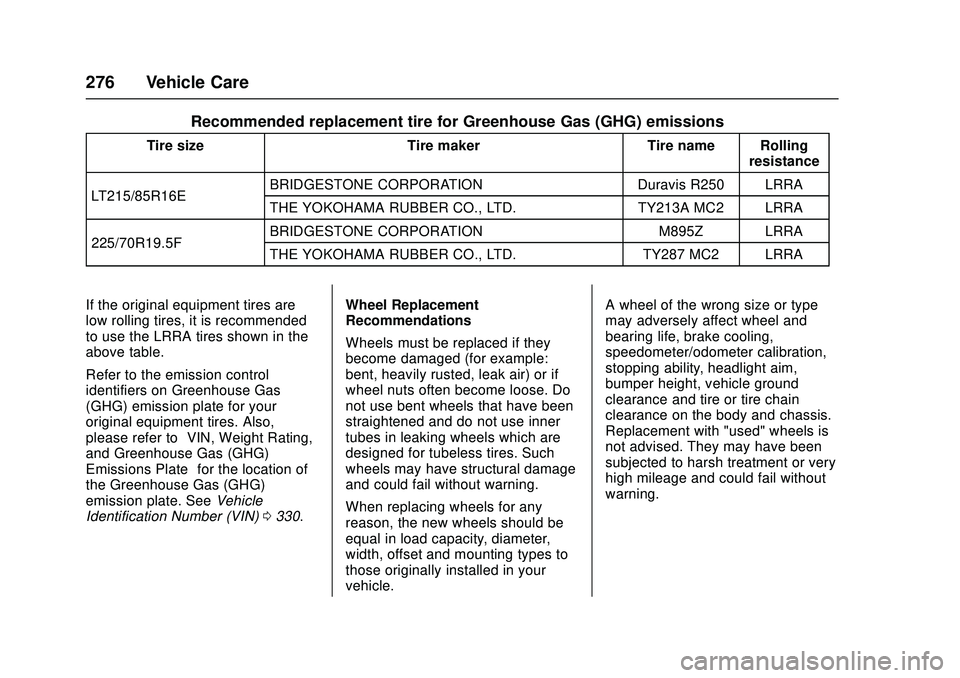
Chevrolet Low Cab Forward Owner Manual (GMNA-Localizing-U.S.-
11254764) - 2018 - crc - 12/5/16
276 Vehicle Care
Recommended replacement tire for Greenhouse Gas (GHG) emissions
Tire sizeTire makerTire name Rolling
resistance
LT215/85R16E BRIDGESTONE CORPORATION
Duravis R250 LRRA
THE YOKOHAMA RUBBER CO., LTD. TY213A MC2 LRRA
225/70R19.5F BRIDGESTONE CORPORATION
M895Z LRRA
THE YOKOHAMA RUBBER CO., LTD. TY287 MC2 LRRA
If the original equipment tires are
low rolling tires, it is recommended
to use the LRRA tires shown in the
above table.
Refer to the emission control
identifiers on Greenhouse Gas
(GHG) emission plate for your
original equipment tires. Also,
please refer to “VIN, Weight Rating,
and Greenhouse Gas (GHG)
Emissions Plate” for the location of
the Greenhouse Gas (GHG)
emission plate. See Vehicle
Identification Number (VIN) 0330. Wheel Replacement
Recommendations
Wheels must be replaced if they
become damaged (for example:
bent, heavily rusted, leak air) or if
wheel nuts often become loose. Do
not use bent wheels that have been
straightened and do not use inner
tubes in leaking wheels which are
designed for tubeless tires. Such
wheels may have structural damage
and could fail without warning.
When replacing wheels for any
reason, the new wheels should be
equal in load capacity, diameter,
width, offset and mounting types to
those originally installed in your
vehicle. A wheel of the wrong size or type
may adversely affect wheel and
bearing life, brake cooling,
speedometer/odometer calibration,
stopping ability, headlight aim,
bumper height, vehicle ground
clearance and tire or tire chain
clearance on the body and chassis.
Replacement with "used" wheels is
not advised. They may have been
subjected to harsh treatment or very
high mileage and could fail without
warning.
Page 290 of 358
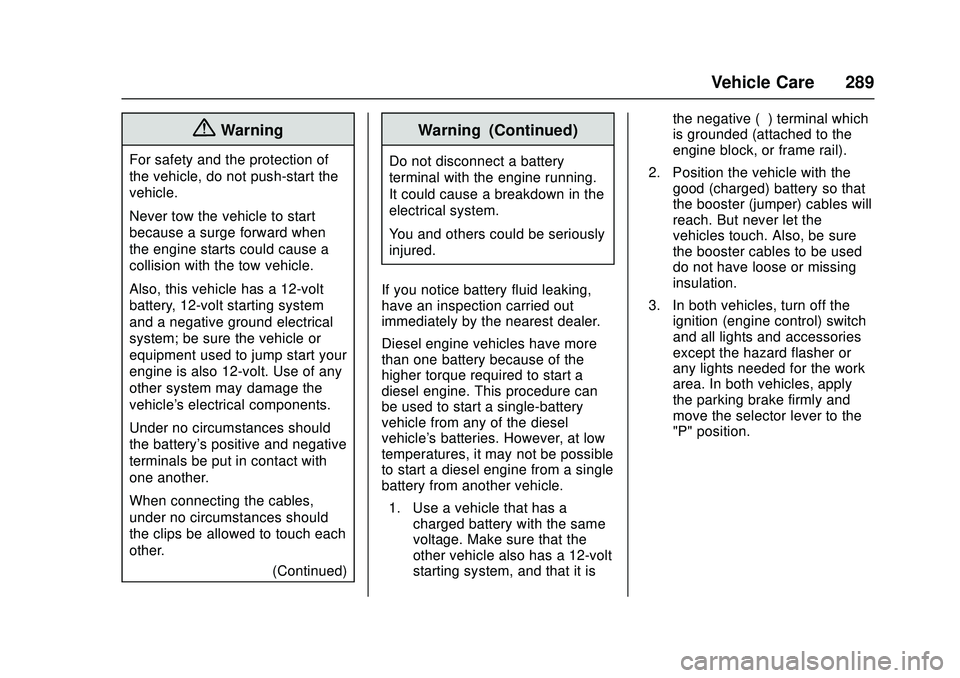
Chevrolet Low Cab Forward Owner Manual (GMNA-Localizing-U.S.-
11254764) - 2018 - crc - 12/5/16
Vehicle Care 289
{Warning
For safety and the protection of
the vehicle, do not push-start the
vehicle.
Never tow the vehicle to start
because a surge forward when
the engine starts could cause a
collision with the tow vehicle.
Also, this vehicle has a 12-volt
battery, 12-volt starting system
and a negative ground electrical
system; be sure the vehicle or
equipment used to jump start your
engine is also 12-volt. Use of any
other system may damage the
vehicle's electrical components.
Under no circumstances should
the battery's positive and negative
terminals be put in contact with
one another.
When connecting the cables,
under no circumstances should
the clips be allowed to touch each
other.(Continued)
Warning (Continued)
Do not disconnect a battery
terminal with the engine running.
It could cause a breakdown in the
electrical system.
You and others could be seriously
injured.
If you notice battery fluid leaking,
have an inspection carried out
immediately by the nearest dealer.
Diesel engine vehicles have more
than one battery because of the
higher torque required to start a
diesel engine. This procedure can
be used to start a single-battery
vehicle from any of the diesel
vehicle's batteries. However, at low
temperatures, it may not be possible
to start a diesel engine from a single
battery from another vehicle. 1. Use a vehicle that has a charged battery with the same
voltage. Make sure that the
other vehicle also has a 12-volt
starting system, and that it is the negative (–) terminal which
is grounded (attached to the
engine block, or frame rail).
2. Position the vehicle with the good (charged) battery so that
the booster (jumper) cables will
reach. But never let the
vehicles touch. Also, be sure
the booster cables to be used
do not have loose or missing
insulation.
3. In both vehicles, turn off the ignition (engine control) switch
and all lights and accessories
except the hazard flasher or
any lights needed for the work
area. In both vehicles, apply
the parking brake firmly and
move the selector lever to the
"P" position.
Page 294 of 358
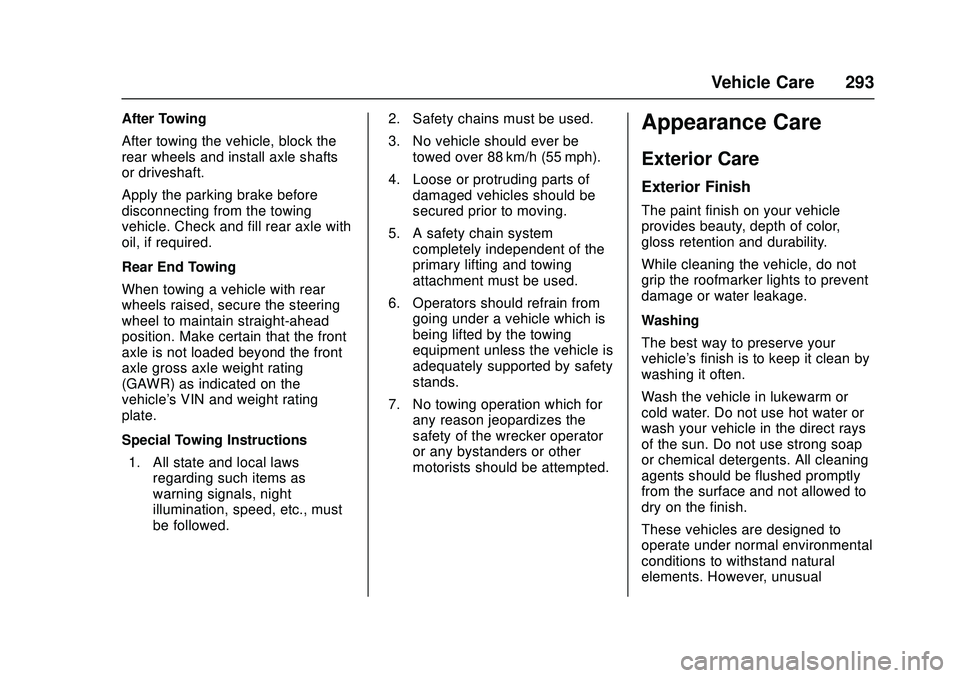
Chevrolet Low Cab Forward Owner Manual (GMNA-Localizing-U.S.-
11254764) - 2018 - crc - 12/5/16
Vehicle Care 293
After Towing
After towing the vehicle, block the
rear wheels and install axle shafts
or driveshaft.
Apply the parking brake before
disconnecting from the towing
vehicle. Check and fill rear axle with
oil, if required.
Rear End Towing
When towing a vehicle with rear
wheels raised, secure the steering
wheel to maintain straight-ahead
position. Make certain that the front
axle is not loaded beyond the front
axle gross axle weight rating
(GAWR) as indicated on the
vehicle's VIN and weight rating
plate.
Special Towing Instructions1. All state and local laws regarding such items as
warning signals, night
illumination, speed, etc., must
be followed. 2. Safety chains must be used.
3. No vehicle should ever be
towed over 88 km/h (55 mph).
4. Loose or protruding parts of damaged vehicles should be
secured prior to moving.
5. A safety chain system completely independent of the
primary lifting and towing
attachment must be used.
6. Operators should refrain from going under a vehicle which is
being lifted by the towing
equipment unless the vehicle is
adequately supported by safety
stands.
7. No towing operation which for any reason jeopardizes the
safety of the wrecker operator
or any bystanders or other
motorists should be attempted.Appearance Care
Exterior Care
Exterior Finish
The paint finish on your vehicle
provides beauty, depth of color,
gloss retention and durability.
While cleaning the vehicle, do not
grip the roofmarker lights to prevent
damage or water leakage.
Washing
The best way to preserve your
vehicle's finish is to keep it clean by
washing it often.
Wash the vehicle in lukewarm or
cold water. Do not use hot water or
wash your vehicle in the direct rays
of the sun. Do not use strong soap
or chemical detergents. All cleaning
agents should be flushed promptly
from the surface and not allowed to
dry on the finish.
These vehicles are designed to
operate under normal environmental
conditions to withstand natural
elements. However, unusual
Page 319 of 358

Chevrolet Low Cab Forward Owner Manual (GMNA-Localizing-U.S.-
11254764) - 2018 - crc - 12/5/16
318 Service and Maintenance
Recommended Daily
(Pre-operation) Inspections
These checks are in addition to, not
instead of, any legally required daily
inspections. See related topics
under "Maintenance Schedule",
especially if problems are found.
For safe and comfortable driving,
keep record of the distances driven
and the condition of the vehicle
during operation. Perform
inspections at appropriate intervals,
and perform maintenance in
accordance with the findings of the
inspections. If an inspection reveals
an abnormality or there was an
abnormality the previous time the
vehicle was driven, have the vehicle
repaired by the nearest dealer
before it is driven again.1. Components that showed abnormalities during the
previous operation
.Check components that
showed abnormalities
during the previous
operation 2. Checks performed at the
engine
.Fan belt looseness and
damage
. Engine oil level
. Engine coolant level
. Power steering fluid level
3. Checks performed from the driver's seat
.Brake fluid level
. Brake pedal free play
. Operation of meters,
gauges and warning/
indicator lights
. Engine startability,
abnormal noise and color of
exhaust gases
. Parking brake lever stroke
. Windshield washer fluid
spray condition and
windshield wiper
effectiveness
. Windshield washer fluid
level .
Steering wheel position and
free play
. Operation of horn and turn
signal lights
. Door lock operation
4. Checks performed during a walk around the vehicle
.Illumination, flashing,
contamination, damage and
obstruction of lights
. Contamination, damage ad
obstruction of windows,
mirrors and reflectors
. Leaf spring damage
. Oil, engine coolant, fuel,
brake fluid and power
steering fluid leaks
. Water separator
5. Checking wheels and tires .Air pressure
. Cracks and other damage
. Abnormal wear
. Tread depth
. Mounting condition of all
wheel nuts
Page 320 of 358

Chevrolet Low Cab Forward Owner Manual (GMNA-Localizing-U.S.-
11254764) - 2018 - crc - 12/5/16
Service and Maintenance 319
6. Checks performed after theengine startup
.Oil, engine coolant, fuel,
brake fluid and power
steering fluid leaks
. Inspect the exhaust system,
checking that the tailpipe is
clear
7. Checks performed while driving the vehicle
.Brake effectiveness
. Engine abnormal noises
Keep the Floor Around the Driver
Seat Clean and Tidy
{Warning
It is extremely dangerous to have
empty cans, empty bottles,
or other items rolling around on
the floor because they could get
trapped under the brake pedal
and prevent brake application.
For proper pedal operation, it is
also essential to lay floor mats (Continued)
Warning (Continued)
properly. Incorrectly installed floor
mats would hinder free movement
of the pedals.
Do not use the dashboard pocket
or the top of the dashboard as a
place to put items that could roll,
which could interfere with your
driving. You and others could be
seriously injured.
Choose Your Footwear Suitable
for Driving
{Warning
Choose footwear that ensures
proper operation of pedals when
driving the vehicle. Use of
footwear unsuitable for driving
may cause an accident. The
driver could be seriously injured
when not wearing the proper
footwear.
Electrical System
Following the after-delivery service,
it is the owner's responsibility to
check all wiring periodically for
cracked, chafed or oil-soaked
insulation and maintain it in a clean
and tight condition to ensure
satisfactory operation of the
electrical system.
Headlights and Turn Signal
Lights
Turn the engine control switch to the
"ON" position, and then check the
way in which the headlights, turn
signal lights, and other exterior
lights come on and flash. In
addition, press the brake pedal to
confirm whether the stop lights
come on, and shift the transmission
to "R" position to confirm whether
the back up lights come on. Also
examine the lights for discoloration,
damage, and looseness.
Page 324 of 358

Chevrolet Low Cab Forward Owner Manual (GMNA-Localizing-U.S.-
11254764) - 2018 - crc - 12/5/16
Service and Maintenance 323
Additional
Maintenance and Care
Owner Safety and Routine
Maintenance
Listed below are vehicle checks
which should be made periodically
by either the owner or a qualified
technician to ensure proper
performance and safety of your
vehicle. Take any problems promptly
to a technician for service advice.
For your safety and that of others,
any of the safety-related
components that may have been
damaged in an accident should be
checked and necessary repairs
performed before operating your
vehicle.
At the minimum, these routine
checks should be made every
6 months or 16,000 km
(10,000 miles), whichever comes
first. Whenever repairs are
necessary, have them completed
before operating the vehicle.A: Parking Brake :
Park on a fairly
steep hill and hold the vehicle with
the parking brake only. This checks
holding ability.
Before checking item (B) below, be
sure to have enough room around
the vehicle. Then firmly apply both
the parking brake see Parking
Brake 0200 and the regular brakes.
Do not use the accelerator pedal.
If the engine starts, be ready to turn
off the engine control switch at
once. Take these precautions
because the vehicle could move
without warning and possibly cause
injury or property damage.
B: Starter Safety Switch : Check
by trying to start the engine in each
gear. The starter should crank only
at selector position "P" or "N".
C: Transmission Shift Indicator :
Check that the indicator points to
the gear chosen.
D: Steering : Be alert for any
changes in steering action. An
inspection or service is needed
when: the steering wheel is harder to turn or has too much free play,
or when there are strange sounds
when turning or parking.
E: Wheel Alignment, Balance, and
Tires :
Check tires for abnormal
wear or damage. Also, check for
damaged wheels. A pull right or left
on a straight and level road may
show the need for a wheel
alignment. A vibration of the
steering wheel or seat at normal
highway speeds may mean a wheel
balancing is needed. Check tire
pressure when the tires are "cold,"
at least monthly, and whenever the
vehicle is serviced.
Check the pressure more often if
daily checks show it's needed.
(Refer to "Recommended Daily
(Pre-operation) Inspections" under
Owner Checks and Services 0317).
Change tire pressure as needed
when changing loads.
F: Brakes : Be alert to illumination
of the brake system warning light or
brake low vacuum warning light
(4500HD, 4500XD models) or the
tone alarm, or changes in braking
action, such as repeated pulling to
Page 325 of 358
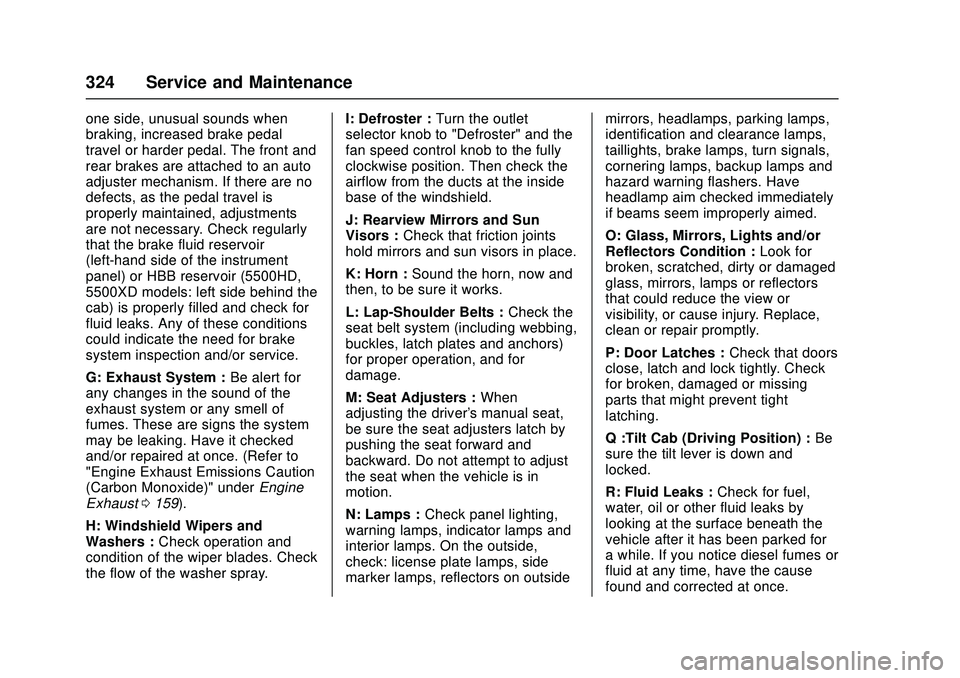
Chevrolet Low Cab Forward Owner Manual (GMNA-Localizing-U.S.-
11254764) - 2018 - crc - 12/5/16
324 Service and Maintenance
one side, unusual sounds when
braking, increased brake pedal
travel or harder pedal. The front and
rear brakes are attached to an auto
adjuster mechanism. If there are no
defects, as the pedal travel is
properly maintained, adjustments
are not necessary. Check regularly
that the brake fluid reservoir
(left-hand side of the instrument
panel) or HBB reservoir (5500HD,
5500XD models: left side behind the
cab) is properly filled and check for
fluid leaks. Any of these conditions
could indicate the need for brake
system inspection and/or service.
G: Exhaust System :Be alert for
any changes in the sound of the
exhaust system or any smell of
fumes. These are signs the system
may be leaking. Have it checked
and/or repaired at once. (Refer to
"Engine Exhaust Emissions Caution
(Carbon Monoxide)" under Engine
Exhaust 0159).
H: Windshield Wipers and
Washers : Check operation and
condition of the wiper blades. Check
the flow of the washer spray. I: Defroster :
Turn the outlet
selector knob to "Defroster" and the
fan speed control knob to the fully
clockwise position. Then check the
airflow from the ducts at the inside
base of the windshield.
J: Rearview Mirrors and Sun
Visors : Check that friction joints
hold mirrors and sun visors in place.
K: Horn : Sound the horn, now and
then, to be sure it works.
L: Lap-Shoulder Belts : Check the
seat belt system (including webbing,
buckles, latch plates and anchors)
for proper operation, and for
damage.
M: Seat Adjusters : When
adjusting the driver's manual seat,
be sure the seat adjusters latch by
pushing the seat forward and
backward. Do not attempt to adjust
the seat when the vehicle is in
motion.
N: Lamps : Check panel lighting,
warning lamps, indicator lamps and
interior lamps. On the outside,
check: license plate lamps, side
marker lamps, reflectors on outside mirrors, headlamps, parking lamps,
identification and clearance lamps,
taillights, brake lamps, turn signals,
cornering lamps, backup lamps and
hazard warning flashers. Have
headlamp aim checked immediately
if beams seem improperly aimed.
O: Glass, Mirrors, Lights and/or
Reflectors Condition :
Look for
broken, scratched, dirty or damaged
glass, mirrors, lamps or reflectors
that could reduce the view or
visibility, or cause injury. Replace,
clean or repair promptly.
P: Door Latches : Check that doors
close, latch and lock tightly. Check
for broken, damaged or missing
parts that might prevent tight
latching.
Q :Tilt Cab (Driving Position) : Be
sure the tilt lever is down and
locked.
R: Fluid Leaks : Check for fuel,
water, oil or other fluid leaks by
looking at the surface beneath the
vehicle after it has been parked for
a while. If you notice diesel fumes or
fluid at any time, have the cause
found and corrected at once.